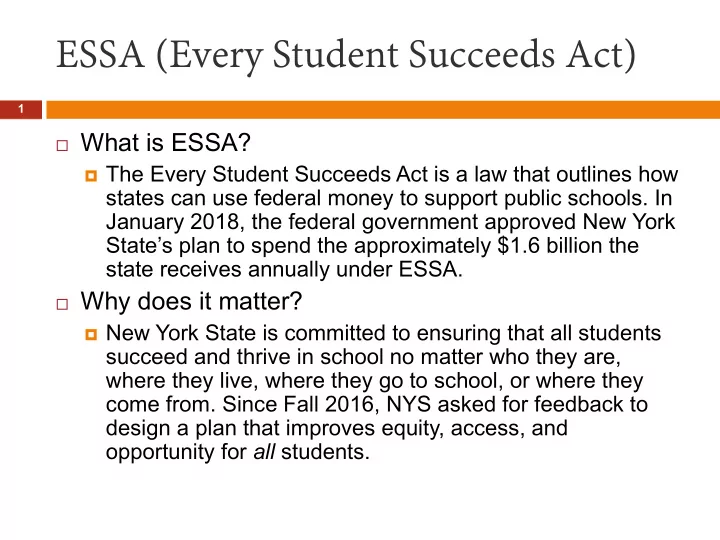

ESSA (Every Student Succeeds Act) 1 What is ESSA? The Every Student Succeeds Act is a law that outlines how states can use federal money to support public schools. In January 2018, the federal government approved New York State’s plan to spend the approximately $1.6 billion the state receives annually under ESSA. Why does it matter? New York State is committed to ensuring that all students succeed and thrive in school no matter who they are, where they live, where they go to school, or where they come from. Since Fall 2016, NYS asked for feedback to design a plan that improves equity, access, and opportunity for all students.
ESSA Accountability Indicators 2 Student Academic Achievement For all schools , based on the Composite Performance Index, which measures achievement based on state assessments in English Language Arts (ELA), Math and Science. For high schools , also measure achievement on state assessments in Social Studies Student Growth For elementary and middle schools , measures students growth on statewide assessments in ELA and Math for students in grades 4-8 by comparing the scores of students in the current ear to the scores of students with similar scores in prior years Academic Progress For all schools , measures student progress on state assessments in ELA and Math against long-term goals and measures of interim progress (MIPs). Graduation Rates For high schools , measures four-, five-, and six-year cohort graduation rates against long-term goals and MIPs English Language Proficiency For all schools , measures the progress of English Language Learners in meeting their individual progress targets on the New York State English as a Second Language Achievement Test (NYSESLAT) Chronic Absenteeism For all schools , measures the percentage of students who miss 10% or more of the school year against long-term goals and MIPs College, Career, and Civic Readiness For high schools , measures the percentage of students who are leaving school prepared for college, career, and civic readiness as measured by diplomas, credentials, advanced course credits and enrollment, career and technical education certifications, and other similar indicators against long-term goals and MIPs NOTE: NYS will add an indicator based on out-of-school suspension rates in 2018-19 (to be used for school identification after 2020-2021) and will consider adding additional indicators in the future.
Accountable Subgroups 3 All students 1. American Indian or Native Alaskan 2. Black or African American 3. Hispanic or Latino 4. Asian or Native Hawaiian/Other Pacific Islander 5. White 6. Multiracial 7. English Language Learner (ELL) 8. Students with Disabilities (SWD) 9. 10. Economically Disadvantaged
Performance Levels 4 For each of the following indicators, every subgroup will be given a level (from 1-4): Student Academic Achievement Student Growth Academic Progress Graduation Rates English Language Proficiency Chronic Absenteeism College, Career, and Civic Readiness
School Identifications 5
Cairo-Durham 2018-2019 6 Identifications Cairo-Durham CSD: Target District Cairo-Durham Elementary: Comprehensive Support and Improvement Cairo-Durham Middle School: Good Standing Cairo-Durham High School: Good Standing Why? Identification at the Elementary School is primarily centered on student growth and academic progress for the “All Students” subgroup Cairo-Durham is automatically made a target district because the elementary school was identified as a CSI Cairo-Durham also received a number of “Level 1s” for different subgroups across the accountability indicators
What Next? 7 All Target Districts are required to develop an annual District Comprehensive Improvement Plan (DCIP)
What Next? 8 All Comprehensive Support & Improvement Schools are required to: Participate in an on-site needs assessment, the Diagnostic Tool for School and District Effectiveness Review additional data and documentation to identify needs to be addressed in the school’s annual improvement plan Conduct annual surveys of parents, staff, and students Develop, in consultation with parents and school staff an annual School Comprehensive Education Plan (SCEP) and submit to NYSED for approval Identify a school-wide evidence-based intervention to be included within the annual improvement plan Beginning in the 2019-2020 school year, establish a participatory budgeting process or an approved alternate means of increasing parent and student participation in decision-making.
Recommend
More recommend